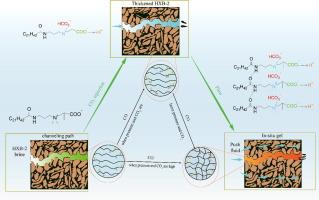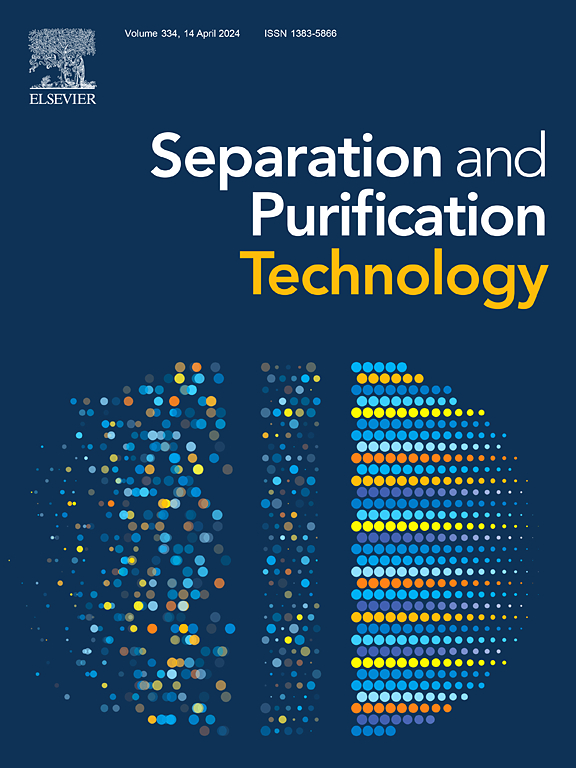An intelligent CO2-responsive hydrogel for applications in enhanced oil recovery and CO2 geological storage
IF 8.1
1区 工程技术
Q1 ENGINEERING, CHEMICAL
引用次数: 0
Abstract
A novel CO2-responsive hydrogel for intelligent control of gas channeling in CO2– enhanced oil recovery (CO2-EOR) and geological CO2 storage has been developed. A monomeric long-chain tertiary amine surfactant (HXB-2) that has specific amide and carboxyl groups was synthesized. The surfactant can interact with CO2 in aqueous solution to increase the viscosity and induce gelation. The hydrogel is irreversible and does not revert to solution phase after N2 bubbling. It shows excellent structural stability and thermal resistance and the viscosity remains four times higher than that of the initial solution upon heating. For the mechanism, HXB-2 protonates in CO2 environment and self-assembles into worm-like micelles (WLMs) under synergistic forces of hydrophobic interaction, hydrogen bonding, and electrostatic interaction, which further crosslink to form a three-dimensional (3D) network to induce gelation. The hydrogel can be formed in-situ to control gas channeling intelligently and redirect the gas to unswept low-permeability channels. It can enhance the recovery rate by 23.53 % and the maximum seepage resistance reaches 29.45 MPa·min·cm−3 for water-alternatinggas flooding. Moreover, by having spontaneous association and shear-dissociation properties, the hydrogel in the rock pores causes minimal damage to the reservoir. This study provides valuable insights and empirical support for the development of irreversible CO2-responsive hydrogels for CO2 chemical sequestration and gas channeling control to help EOR and geological CO2 storage.

应用于提高石油采收率和二氧化碳地质封存的智能二氧化碳响应水凝胶
我们开发了一种新型二氧化碳响应水凝胶,用于智能控制二氧化碳强化采油(CO2-EOR)和二氧化碳地质封存中的气体通道。合成了一种具有特定酰胺基和羧基的单体长链叔胺表面活性剂(HXB-2)。这种表面活性剂能与水溶液中的二氧化碳相互作用,增加粘度并诱导凝胶化。这种水凝胶是不可逆的,在通入 N2 后不会恢复到溶液相。它显示出优异的结构稳定性和耐热性,加热后粘度仍比初始溶液高四倍。在机理方面,HXB-2 在二氧化碳环境中质子化,并在疏水作用、氢键和静电作用的协同作用下自组装成蠕虫状胶束(WLMs),进一步交联形成三维(3D)网络,从而诱导凝胶化。这种水凝胶可以在原位形成,从而智能控制气体通道,并将气体重新引导到未扫过的低渗透通道。它能将采收率提高 23.53%,在水-交替气体淹没情况下,最大抗渗能力达到 29.45 MPa-min-cm-3。此外,岩石孔隙中的水凝胶还具有自发结合和剪切解离特性,对储层的破坏极小。这项研究为开发用于二氧化碳化学封存和气体通道控制的不可逆二氧化碳响应水凝胶提供了宝贵的见解和经验支持,有助于 EOR 和二氧化碳地质封存。
本文章由计算机程序翻译,如有差异,请以英文原文为准。
求助全文
约1分钟内获得全文
求助全文
来源期刊

Separation and Purification Technology
工程技术-工程:化工
CiteScore
14.00
自引率
12.80%
发文量
2347
审稿时长
43 days
期刊介绍:
Separation and Purification Technology is a premier journal committed to sharing innovative methods for separation and purification in chemical and environmental engineering, encompassing both homogeneous solutions and heterogeneous mixtures. Our scope includes the separation and/or purification of liquids, vapors, and gases, as well as carbon capture and separation techniques. However, it's important to note that methods solely intended for analytical purposes are not within the scope of the journal. Additionally, disciplines such as soil science, polymer science, and metallurgy fall outside the purview of Separation and Purification Technology. Join us in advancing the field of separation and purification methods for sustainable solutions in chemical and environmental engineering.
 求助内容:
求助内容: 应助结果提醒方式:
应助结果提醒方式:


